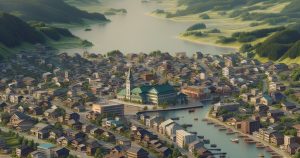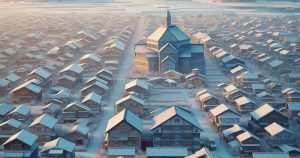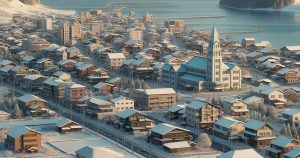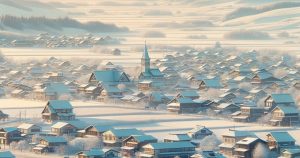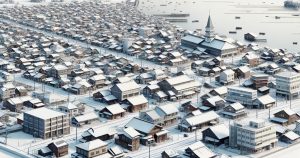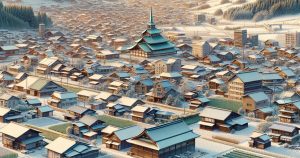| population | 42,900 peoples |
|---|---|
| area | 212.21 km² |
| population density | 202 peoples/km² |
Located in southern Hokkaido, Noboribetsu City is a renowned hot spring destination rich in nature, history, and culture. Once home to the indigenous Ainu people, it flourished during the Meiji era as a major onsen town. Today, Noboribetsu remains one of Japan’s most famous spa resorts, known for its dynamic geothermal landscape, particularly the steaming “Jigokudani” (Hell Valley). The city’s economy is supported by tourism, dairy farming, and fishing, with daily life closely tied to the surrounding environment. The local dialect, a variation of Hokkaido-ben, and the enduring influence of Ainu culture give Noboribetsu a distinct regional identity. Annual festivals such as the Noboribetsu Hell Festival and the Hot Spring Fireworks Festival showcase the city’s lively spirit and cultural heritage, attracting visitors from across Japan and abroad. Life in Noboribetsu is deeply connected to its hot springs, pristine nature, and warm community, offering a truly authentic Hokkaido experience.
Cultural Traditions
Noboribetsu’s culture is a harmonious blend of natural beauty and Ainu heritage. Traditional Ainu performances, including the sacred “Kuma Mai” (Bear Dance) and the chanting of epic poems known as “Yukar,” are still preserved and celebrated. Since its development as a hot spring town in the Meiji era, Noboribetsu Onsen has remained the city’s cultural and economic hub. The annual “Jigokudani Hell Festival” is one of the most spectacular events, featuring the fiery “Oni Hanabi” (Demon Fireworks) and a parade of the legendary King Enma through the steamy streets. In recent years, the city has also embraced sustainable initiatives such as geothermal power generation and environmental education. Noboribetsu continues to be a place where people live in balance with nature, honoring both its Ainu roots and modern tourism heritage.
Local Specialties
- Jigokudani (Hell Valley): The city’s iconic geothermal valley where sulfurous steam vents rise from volcanic craters, creating a mystical landscape. Visitors can walk the well-maintained trails to observe the natural hot springs and geysers up close.
- Noboribetsu Marine Park NIXE: A Scandinavian-style aquarium housed in the “NIXE Castle.” Highlights include penguin parades, seal shows, and mesmerizing jellyfish exhibits, making it a favorite for families.
- Noboribetsu Bear Park: Home to around 70 brown bears, this mountain-top wildlife park allows visitors to feed and observe these powerful animals in a natural setting accessible via ropeway from the onsen area.
- Noboribetsu Onsen: Known as the “Department Store of Hot Springs,” it offers nine different types of natural springs, from sulfur to iron and salt baths, each with unique healing and beauty benefits.
- Noboribetsu Dairy Farm Museum: A local facility offering fresh milk, cheese, and pudding made from locally produced dairy. The “Noboribetsu Milk” and “Oni Densetsu Beer” are particularly popular souvenirs.
Annual Events
- Noboribetsu Hell Festival: Held in summer, this vibrant event brings the legend of Hell Valley to life with demons, parades, and fireworks that illuminate the night sky.
- Noboribetsu Marathon: A popular early-summer race that takes runners through scenic mountain and onsen landscapes, combining sport and relaxation in true Hokkaido style.
- Noboribetsu Snow Light Path: In winter, handmade snow and ice lanterns line the streets of the hot spring town, creating a romantic and serene atmosphere under the starry sky.
- Noboribetsu Autumn Festival: A harvest-themed event celebrating local food and craftsmanship, featuring seasonal dishes, handmade goods, and live music.
- Noboribetsu Citizens’ Cultural Festival: Held annually on Culture Day, this event showcases local art, calligraphy, music, and dance, highlighting the community’s rich cultural spirit.
Access
- By Air: From New Chitose Airport, Noboribetsu is about one hour away by car or bus. Airport limousine buses and rental cars provide easy connections.
- By Train: From New Chitose Airport, take the JR Chitose Line to Chitose Station and transfer to the JR Muroran Line. The journey to Noboribetsu Station takes about 90 minutes, followed by a 15-minute bus ride to the onsen area.
- By Car: Access via the Dōō Expressway (Noboribetsu East IC or Noboribetsu-Muroran IC), roughly 10 minutes from the city center. Route 36 also provides a scenic drive from Sapporo or Tomakomai.
- By Highway Bus: Direct buses from Sapporo take approximately two hours. Airport shuttles from New Chitose also operate regularly to Noboribetsu Onsen.
- By Ferry: Travelers can reach Hokkaido via ferry from Aomori or Hachinohe to Tomakomai Port, then drive about 90 minutes to Noboribetsu—an ideal route for road trips.
Tourist Attractions
- Jigokudani (Hell Valley) – The most famous attraction in Noboribetsu, offering dramatic volcanic scenery, steam vents, and sulfur springs. A network of walking trails allows close-up exploration.
- Noboribetsu Marine Park NIXE – A family-friendly aquarium with themed exhibits, live shows, and interactive experiences featuring marine life from around the world.
- Noboribetsu Bear Park – Reachable via ropeway, the park offers breathtaking views and up-close encounters with Hokkaido’s brown bears in their natural environment.
- Karurusu Onsen – A peaceful mountain hot spring area known for its clear, gentle waters and tranquil atmosphere, perfect for those seeking quiet relaxation.
- Noboribetsu Date Jidaimura – A historical theme park recreating the Edo period with samurai performances, ninja shows, and hands-on cultural experiences.


